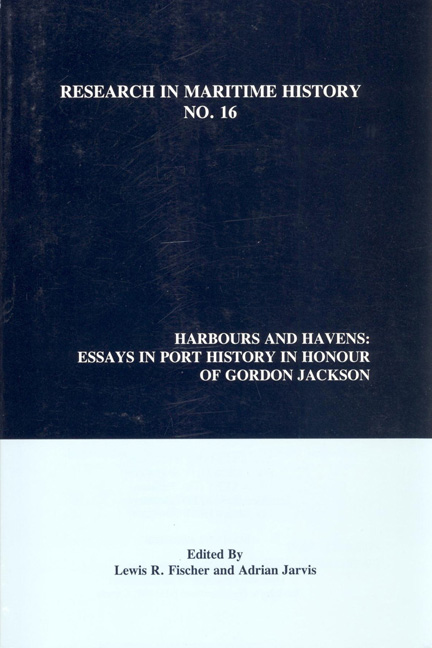Book contents
- Frontmatter
- Contents
- About the Editors
- Contributors
- Introduction
- “Gordon Jackson: An Appreciation”
- “Port History: Some Thoughts on Where it Came from and Where it Might be Going”
- “Port Politics: Interest, Faction and Port Management in Mid-Victorian Liverpool”
- “Our Little Company:' The Wilsons and North Eastern Railway Shipping Company Limited, 1906-1935”
- “The Changing Functions of a Rural Port: Dumfries, 1700-1850”
- “Australian Ports Since 1945”
- “Aspinall, Cornes and Company and the Early Development of the Port of Yokohama”
- “Dubai: From Creek to Global Port City”
- “New York's German Suburb: The Creation of the Port of Bremerhaven, 1827-1918”
- “Capital and Labour in the Port Town of Esbjerg, 1945- 1999”
- “Port Policies: Seaport Planning around the North Atlantic, 1850-1939”
- “Gordon Jackson: A Bibliography”
“Capital and Labour in the Port Town of Esbjerg, 1945- 1999”
- Frontmatter
- Contents
- About the Editors
- Contributors
- Introduction
- “Gordon Jackson: An Appreciation”
- “Port History: Some Thoughts on Where it Came from and Where it Might be Going”
- “Port Politics: Interest, Faction and Port Management in Mid-Victorian Liverpool”
- “Our Little Company:' The Wilsons and North Eastern Railway Shipping Company Limited, 1906-1935”
- “The Changing Functions of a Rural Port: Dumfries, 1700-1850”
- “Australian Ports Since 1945”
- “Aspinall, Cornes and Company and the Early Development of the Port of Yokohama”
- “Dubai: From Creek to Global Port City”
- “New York's German Suburb: The Creation of the Port of Bremerhaven, 1827-1918”
- “Capital and Labour in the Port Town of Esbjerg, 1945- 1999”
- “Port Policies: Seaport Planning around the North Atlantic, 1850-1939”
- “Gordon Jackson: A Bibliography”
Summary
Throughout the twentieth century employment has contracted in most port towns in Western Europe and inhabitants accordingly have lost much of their dependence on maritime businesses. Key technological factors underlying this process have been mechanisation and containerisation, which together have enabled a shrinking work force to shift more cargo with increasing speed. The consequence of the development of liner shipping and containerisation has been to concentrate half the world's container handling in no more than twenty ports world-wide, leaving the remainder to survive as feeder terminals or to transform their infrastructure into marinas and business parks. Likewise, resource depletion and concentration have caused many fishing ports to surrender their traditional ways and seek new leases of life as tourist destinations or residential areas. Needless to say, the ports that did not make the transformation, or which lacked the natural beauty, have often been left as desolate industrial sites.
At a conference on port history held in Esbjerg in 1991, Gordon Jackson remarked that “ports are living organisms” that have to adapt to changing demands and an often shifting commercial environment. Adaptation may take various forms, from hostility to eager acceptance. While any decision on the allocation of capital plays a decisive role in the fate of a port town, the flexibility of the local labour market, or the willingness of individuals to adapt to change, should not be overlooked. Especially after 1965, rationalisation and automation caused the demand for manual labour to decrease steadily, and in many ports this process was accompanied by wildcat strikes and public outcry over empty quays. The effects of this change led in many port towns to a social trauma which will likely always remain with the generation that lived through them.
The problem for many ports in coping with change was the scarcity of capital. Investments came mainly from outside the port city, and when its competitive advantage vanished there was little incentive for outside investors to risk their capital. Old maritime centres in northwestern Europe, such as Bremerhaven and Liverpool, were scarred by the loss of capital and jobs from the 1970s. In other ports, however, labour was shifted relatively easily into other industrial sectors.
- Type
- Chapter
- Information
- Harbours and HavensEssays In Port History In Honour Of Gordon Jackson, pp. 213 - 228Publisher: Liverpool University PressPrint publication year: 1998



